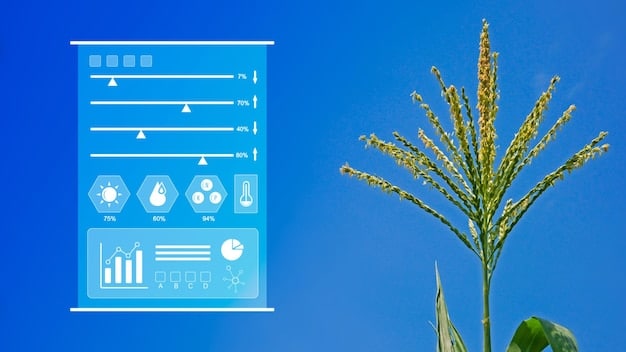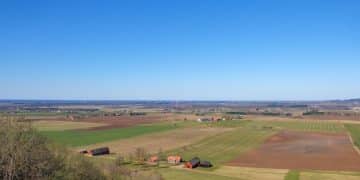US Crop Insurance Trends: Analyzing Prevented Planting Claim Increases

US crop insurance trends indicate a notable surge in prevented planting claims, primarily driven by adverse weather conditions and evolving agricultural practices, impacting both farmers and the insurance industry.
The landscape of US crop insurance is undergoing significant shifts, with a noticeable increase in prevented planting claims. This trend raises important questions about the factors driving these claims and their broader implications for the agricultural sector. Understanding these **US crop insurance trends** is crucial for farmers, policymakers, and insurance providers alike.
us crop insurance trends: drivers behind prevented planting claims
The increase in prevented planting claims within the US crop insurance system is a multifaceted issue. It’s essential to examine the primary drivers behind this trend to gain a comprehensive understanding of its implications. These factors include changing weather patterns, evolving agricultural practices, and economic considerations influencing farmer decisions.
adverse weather conditions
Extreme weather events are becoming more frequent and intense, directly impacting planting schedules. Prolonged periods of heavy rain, droughts, and flooding can render fields unplantable, leading to a surge in prevented planting claims.
evolving agricultural practices
Modern farming practices, while aimed at maximizing yields, can sometimes contribute to increased vulnerability. Factors like monoculture and intensive tillage can deplete soil health and reduce its ability to withstand extreme weather.
Here are some key elements that contribute to the rise in prevented planting claims:
- Increased Precipitation: Regions experiencing higher-than-average rainfall during planting seasons.
- Prolonged Droughts: Areas facing extended periods of drought, making planting impossible.
- Flooding Events: Fields inundated by floods, preventing timely planting.

Understanding these drivers is crucial for stakeholders to adapt and mitigate the impact of these trends. By addressing the root causes, the agricultural sector can work towards greater resilience and stability.
the role of prevented planting coverage
Prevented planting coverage is a vital component of US crop insurance, offering financial protection to farmers who are unable to plant their crops due to insurable causes. This coverage helps mitigate losses and provides a safety net during challenging times.
Prevented planting coverage generally kicks in when:
- Natural disasters prevent planting.
- Specific weather conditions, such as excessive rainfall or drought, hinder planting.
- An insurable cause of loss occurs before planting.
understanding coverage levels
Farmers can choose different coverage levels, influencing the amount of indemnity they receive in the event of prevented planting. Higher coverage levels offer greater protection but also come with higher premiums.
eligibility requirements
To be eligible for prevented planting coverage, farmers must meet certain requirements, including having a history of planting the insured crop, demonstrating the intent to plant, and following good farming practices.
The significance of prevented planting coverage cannot be overstated:
- Financial Security: Provides a financial safety net for farmers facing planting challenges.
- Risk Mitigation: Helps mitigate the economic impact of adverse weather and other insurable causes.
- Stability: Contributes to the overall stability of the agricultural sector.
By understanding the nuances of prevented planting coverage, farmers can make informed decisions about their insurance needs and protect their livelihoods.
impact on farmers and the agriculture industry
The increase in prevented planting claims has far-reaching consequences for farmers and the broader agriculture industry. These impacts extend beyond immediate financial losses, affecting planting decisions, market dynamics, and the overall resilience of the sector.
financial challenges for farmers
Farmers who are unable to plant their crops face significant financial challenges. Loss of income, coupled with the costs of maintaining land and equipment, can create a difficult economic situation.
market implications
Prevented planting can disrupt supply chains, leading to price volatility and uncertainty in agricultural markets. Shortages of certain crops can drive up prices, impacting consumers and downstream industries.

The effects of prevented planting are widespread and need to be considered.
- Reduced Yields: Overall crop yields are negatively affected, reducing the total production.
- Economic Losses: Farmers experience significant economic losses due to lack of harvest.
- Market Instability: Market prices can fluctuate dramatically due to supply shortages.
Addressing these impacts requires a collaborative effort from farmers, policymakers, and insurance providers. By working together, the agricultural sector can build greater resilience and adapt to changing conditions.
analyzing regional variations
Prevented planting claims vary significantly across different regions of the United States. Factors such as climate, soil type, and predominant crops influence the frequency and severity of these claims. Analyzing these regional variations is crucial for tailoring insurance products and risk management strategies.
midwest region
The Midwest, known as the “Corn Belt,” often experiences prevented planting claims due to excessive rainfall and flooding. The region’s reliance on corn and soybean production makes it particularly vulnerable to planting delays.
southern region
The Southern region faces different challenges, including droughts and hurricanes. These weather events can significantly impact planting schedules and increase the risk of prevented planting claims.
A few regional distinctions stand out:
- Midwest: Dominated by corn and soybean, susceptible to heavy rainfall during planting.
- Southern US: Vulnerable to droughts and hurricanes, affecting cotton and peanut crops.
- Western US: High risk of drought conditions, impacting wheat and specialty crops.
Understanding these regional variations is essential for developing localized solutions and providing targeted support to farmers in need.
strategies for mitigation and adaptation
Mitigating the risk of prevented planting claims requires a multi-pronged approach that includes adopting resilient farming practices, improving drainage infrastructure, and enhancing crop insurance products. By implementing these strategies, the agricultural sector can reduce its vulnerability to adverse weather and other insurable causes.
resilient farming practices
Implementing practices like cover cropping, no-till farming, and crop diversification can improve soil health and reduce the risk of prevented planting. These practices enhance the soil’s ability to absorb water and withstand extreme weather conditions.
improving drainage infrastructure
Investing in drainage infrastructure, such as tile drainage systems, can help remove excess water from fields and improve planting conditions. This is particularly important in regions prone to heavy rainfall and flooding.
Some effective strategies include:
- Enhanced Crop Insurance: Improving insurance policies to better cover prevented planting scenarios.
- Better Water Management Practices: Implementing effective irrigation and drainage systems.
- Sustainable Agriculture: Promoting farming techniques that enhance soil health and resilience.
By adopting these mitigation and adaptation strategies, the agricultural sector can become more resilient to the challenges posed by changing weather patterns and other factors.
future outlook and policy considerations
Looking ahead, the trend of increasing prevented planting claims is likely to continue, driven by ongoing climate change and evolving agricultural practices. Policymakers, insurance providers, and farmers must work together to develop effective strategies for managing this risk and ensuring the long-term sustainability of the agricultural sector.
the role of climate change
Climate change is expected to exacerbate extreme weather events, leading to more frequent and severe planting delays. This underscores the need for proactive measures to adapt to these changing conditions.
policy implications
Policymakers should consider reforms to crop insurance programs to better address the challenges posed by prevented planting. This may include adjusting coverage levels, streamlining claims processes, and promoting resilient farming practices.
Future considerations involve:
- Policy Adjustments: Adapting crop insurance policies to cope with increased prevented planting.
- Climate Change Adaptation: Implementing practices that help farmers adapt to changing climatic conditions.
- Investment in Infrastructure: Allocating resources for improving drainage and water management systems.
By addressing these policy considerations, the agricultural sector can better navigate the challenges ahead and ensure a sustainable future for farming in the United States.
| Key Point | Brief Description |
|---|---|
| 🌧️ Weather Impact | Extreme weather increases prevented planting claims. |
| 🛡️ Coverage Role | Prevented planting coverage offers financial security. |
| 🌱 Farmer Impact | Farmers face financial losses and market instability. |
| 🗺️ Regional Variations | Claim variations differ across regions due to diverse climates. |
faq
▼
A prevented planting claim is usually triggered by adverse weather, such as excessive rainfall, drought, or flooding, which makes it impossible to plant crops within the designated planting period.
▼
Crop insurance provides indemnity to farmers who are unable to plant their insured crops due to covered causes, helping to offset the financial losses incurred from not being able to plant.
▼
Climate change is increasing the frequency and severity of extreme weather events, while unsustainable farming practices can reduce soil resilience, both contributing to more prevented planting.
▼
The Midwest and Southern regions are particularly vulnerable, with the Midwest often experiencing excessive rainfall and the South being impacted by droughts and hurricanes.
▼
Farmers can mitigate the risk by adopting resilient farming practices, improving drainage infrastructure, and ensuring they have adequate crop insurance coverage tailored to their specific needs.
conclusion
Understanding the trends in US crop insurance, particularly the increase in prevented planting claims, is crucial for all stakeholders in the agricultural sector. As weather patterns continue to evolve and impact planting schedules, proactive measures and adaptive strategies are essential to ensure the resilience and sustainability of farming in the United States. Collaboration between farmers, policymakers, and insurance providers will be key to navigating these challenges and securing the future of agriculture.





